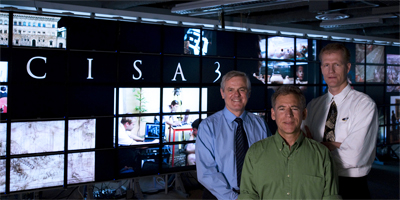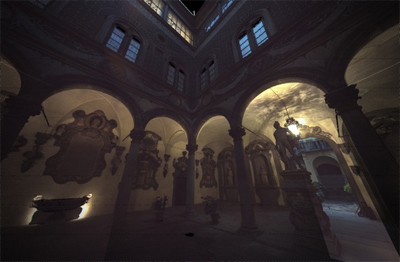NSF Funds UC San Diego Program in Engineering to Preserve Cultural Treasures
San Diego, August 4, 2010 -- Graduate students at the University of California, San Diego will get a unique opportunity to undertake interdisciplinary research and education in a field that is at once very new and very old: developing advanced imaging, information and visualization technologies to diagnose, monitor and safeguard great works of art, historic monuments and archaeological artifacts.
|
The project will be carried out through UC San Diego’s Center of Interdisciplinary Science for Art, Architecture and Archaeology (CISA3), a partnership of the California Institute for Telecommunications and Information Technology (Calit2), Jacobs School of Engineering, and the Division of Arts & Humanities.
“Three years ago, the campus made a commitment to build a center to champion a technology-oriented approach to art diagnostics and conservation,” said UC San Diego Chancellor Marye Anne Fox. “While CISA3 will continue to count on private donors to help fund specific, high-profile projects, the NSF award is a validation of the university’s pioneering role in a new field that is both interdisciplinary and international in scope.”
|
“This project is expected to support 42 grad students during the five-year period and expose them to international field experiences in Italy and the Middle East,” said Falko Kuester, principal investigator on the cultural heritage project and a professor of structural engineering as well as computer science and engineering at UCSD’s Jacobs School of Engineering. “They will be on the vanguard of a new generation of Ph.D.’s equipped to develop and employ diagnostic methodologies and analytical tools for the conservation of historic artifacts.”
The IGERT graduate students will primarily come from structural engineering, computer science, electrical engineering, anthropology and materials science, and they will collaborate with students from art history and other fields of the arts and humanities.
|
“This is a global problem, and today engineering offers the best hope for improving stewardship of these cultural assets and reversing decades or even centuries of damage,” said co-principal investigator Maurizio Seracini, director of CISA3 in Calit2, which will administer the IGERT grant. “The IGERT TEECH project will center on a new methodology, borrowed from medicine, to change how we evaluate, monitor and improve the condition of cultural artifacts.”
Specifically, students will develop methodologies and techniques for the creation of ‘digital clinical charts’ – a concept pioneered by CISA3’s Seracini. The charts capture a baseline understanding of an artifact’s health, then monitor that health over time, as a prelude to making decisions about restoration, repair and other solutions. The health-monitoring methodologies will incorporate multispectral imaging, non-invasive materials characterization, diagnostic and predictive modeling, simulation, data synthesis and visual analytics, cyberinfrastructure development and the creation of more efficient data collection techniques and analytical tools.
“When the digital clinical chart is coupled with the creation of ‘portal science’ communities, future researchers will be able to achieve the full research potential of cyberinfrastructure,” added Thomas E. Levy, an associate director of CISA3 and co-PI on the IGERT grant. According to Levy, distinguished professor of anthropology and archaeology at UC San Diego, “Until now field scientists, curators, restorers and other stewards of cultural heritage have largely depended on subjective assessment and what’s visible to the naked eye to understand or reverse the damage and decay done to the artifact. The clinical-chart focus of this project will establish an objective, scientific basis for monitoring artifacts of cultural heritage, and this methodology could become a standard for museums, galleries and other international efforts to execute sound decision-making with regard to safeguarding artifacts, historic structures and their regional cultural settings. For students interested in melding archaeology, engineering and information technology, it will be ‘deep-time’ cultural questions that will drive their NSF IGERT research and instruction at CISA3. ”
Diagnostic engineering for cultural heritage is a relatively new field that has emerged from forensic science and engineering – the application of engineering sciences to the investigation of failures, failure mechanisms or other performance problems. “Reconstructing failure mechanisms and specifying how to counteract such failures and defects are particularly suited to a graduate education and research program,” noted PI Kuester, an associate director of CISA3. “Even for students who do not plan on careers in cultural heritage, this type of forensic engineering forces students to draw on core concepts in science, engineering, medicine and even the arts for solutions. It promotes curiosity, thoroughness, diligence, and out-of-the-box thinking, which are vital for future leaders in the engineering and science disciplines.”
Students will learn and refine techniques for assessing cultural artifacts and structures that they can later adapt to other fields of knowledge: e.g., the same methodologies and techniques can be applied to the analysis of degraded or obsolete infrastructure, such as public buildings, roads, and bridges, and almost any other engineered component, system, or cultural system.
CISA3 is a partnership of Calit2, the Jacobs School, and UCSD’s Division of Arts & Humanities, with existing lab and classroom space on the La Jolla campus. The project will also take advantage of one-of-a-kind facilities abroad, including a 2,000-square-foot residential and classroom space in Florence, Italy, provided by the Region of Tuscany, and an archaeological field station in Faynan, Jordan. International academic partners will include the University of Florence Schools of Engineering and Architecture, and Israel’s Weizmann Institute of Science and Hebrew University.
Related Links
NSF
IGERT
CISA3
UC San Diego
Jacobs School of Engineering
UCSD Arts & Humanities
Media Contacts
Doug Ramsey, 858-822-5825, dramsey@ucsd.edu




